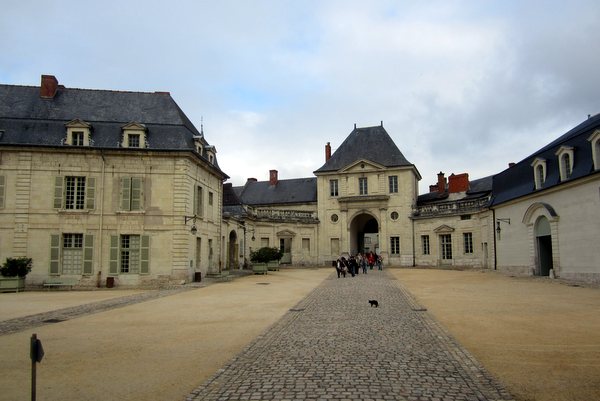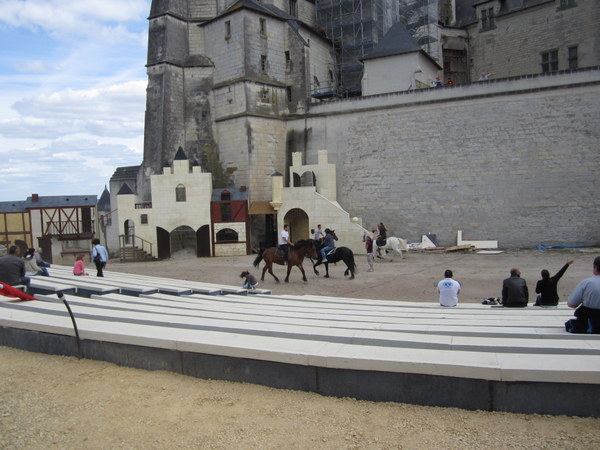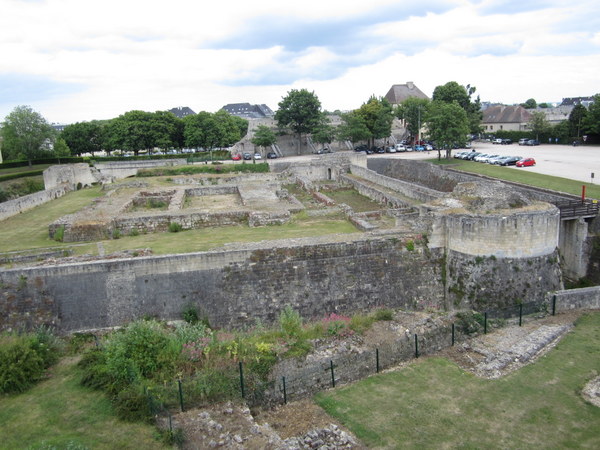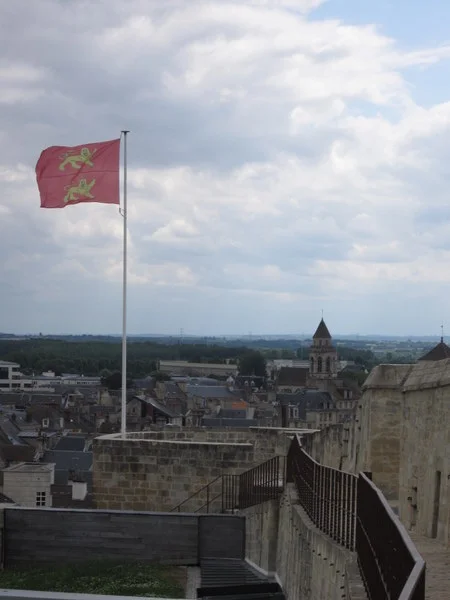Journal Excerpt, Monday, June 13, 2011, Hotel Mercure (continued), [After our tour of Fontevraud] [Mr. Pierre Romanet] drove me to Chinon. I was delighted to be able to get a look at that. Huge also. Not as big as Caen. High upon a promontory – great views of the city below. Steep ascent. White stone, wider stair, but original? Dogs had a tower but it seemed it was also used for baking. Drove the dogs nuts if so. Then [Pierre and I] had a bite to eat and went to a cave – a wine cellar where he gave me a tour. He knows a good bit about wine. Then we visited a town at the confluence of the Vienne and the Loire Rivers named Candes-St. Martin where there is an important Romanesque Church. It was built on the site of an earlier church, which had history with St. Martin, a reluctant bishop. I believe he was born there. In those days, it was called Canes, or something like that, which was renamed Candes-St. Martin in his honor. We toured that church, walking through the lovely town on the way to and from. Then we headed back. A day well spent.
Continued from the previous blog entry, "Abbey at Fontevraud, Eleanor's Final Resting Place".
The plaque that identifies the Chateau at Chinon as part of the Department of the Loire Valley, an historical landmark.
Chinon Chateau has some extraordinary history. This is the fortress where Joan of Arc was interviewed AND where the Knights Templar were held captive. I was continually astounded during this tour with Pierre! Here was a fortress so intact you could easily see it populated with soldiers and civilians and their servants. The walkways over the hillside connecting the towers were fun to hike across. I could look down from a tower to a lower level where other people were walking. And most of the existing structures were built by Henry II in the 12th century, which connects it all to Eleanor of Aquitaine. Of course!
Looking down at a lower level walkway from the top of Coudray Tower at the Chinon Chateau.
There is evidence that the rock promontory on which the chateau stands has been inhabitated since prehistoric times. The site is geographically strategic, not only because of its height atop a cliff face, but also because it sits on a major trade route near the intersection of the Loire and Vienne rivers. A Greco-Roman castrum, or fortified military camp, was constructed here around the 5th century. The first castle and fortress were built here in the 10th century by Theobald I, Count of Blois, but lost to Fulk III, Count of Anjou in 1037.
The Chinon Chateau from a view looking east across the river. I think the equipment in the foreground might be for dredging the river.
From 1044 until the early 13th century, the castle belonged to the House of Anjou and came into the control of Henry Plantagenet. This is where Eleanor of Aquitaine comes into the story: Henry Plantagenet is also Henry II of England, Eleanor's second husband. There are so many connections back to Eleanor along the western edge of the Loire valley, which I confess I knew going in. I wanted to spend some time here.
A site drawing of the entire Chinon Chateau derived from original work by Agnès Dahan and used under the Copyleft Attitude Free Art License 1.3 (FAL 1.3).
Henry II's younger brother, who probably inherited Chinon Chateau at the death of their father Geoffrey, rebelled against Henry and took possession of Chinon. Henry besieged the fortress and took it back. He then installed a treasury and maintained an arsenal there. It was one of Henry's favorite residences, and it is where he died in 1189.
Tour de Chiens. [Photo by "No machine-readable author provided. LonganimE assumed (based on copyright claims)."] Usage rights granted by Creative Commons CC BY-SA 2.5, via Wikimedia Commons
I went through the Tour de Chiens or tower of the dogs, It was used as a bake house at street level and was not too dissimilar from the abbey kitchen except it had multiple levels. And for some reason, the lower level was where the dogs were housed, hence its name. It would have been torture for the dogs if it was a place where they roasted meat. The dogs probably did not care too much about the baking. Although it is possible that the tower was used for baking in a different century from when it was used to house dogs. There is a lot of history that has passed through this place!
The Tour du Coudray. [Photo by "No machine-readable author provided. LonganimE assumed (based on copyright claims)."] Usage rights granted by Creative Commons CC BY-SA 2.5, via Wikimedia Commons
The Tour du Coudray, built by Philip II in the early 13th century, was turned into a prison to house the Knights Templar in the early 14th century when they were accused of heretical practices by Philip IV. Historians believe the true reason for their imprisonment was that he thought they had accumulated too much land in France which meant they rivaled him in power in his own kingdom. (They had also previously rejected him as a Templar.)
A view of the Tour de Boissay from the Tour de Courdray.
As soon as you enter the dungeon, An a/v presentation begins. One of the lieutenants of the templars at the time “narrates” his story and his experience as a captive. The real knight left graffiti on the walls, which you can still see. You can see several photos of the graffiti at the Templars web site.
Another resident of the Tour de Courdray was Joan of Arc in the 15th century.
The Tour de l'Horloge or clock tower straddles the entrance to the center portion of the chateau. Inside is a small museum dedicated to Joan of Arc. Joan came to visit the Dauphin, Charles VII of France who was living at Chinon in exile. According to travelfranceonline.com, when the audience was granted, the Dauphin hid in the crowd at the Great Hall and had one of his servants pretend to be him. Joan was not fooled and picked him out of the crowd. The Dauphin then sent Joan to Poitiers to be cross-examined for 3 weeks. Afterwards, he was convinced that she was telling the truth when she said she had a message from God, and sent her and her followers with supplies to join the rest of the French army. Joan helped rally the French troops and they eventually beat back the British and restored the French crown. Unfortunately, the English captured Joan and burned her at the stake at Rouen.
Me in front of the restored Royal Residence. Photo by Mr. Pierre Romanet.
As our last stop at the Chateau, we paused at the restored Royal Residence or Logis Royal, the apartments built by Henry II. In ruins for many centuries, they were restored around 2006. I did not go inside. I understand from reading that the two-story apartments were connected to the Great Hall, now mostly in ruins, by an outdoor gallery. There were four rooms on each floor. Some rooms still have Gothic fireplaces. I guess I'll have to catch that next trip!
A half-timbered building in Chinon housing a beautiful cafe at street level and probably apartments above.
Pierre suggested I walk around the town center, which looked like it hadn't changed since the 17th century. Many half-timbered houses faced the street. They were painted in bright red and green accents. Most of the structures had businesses on the street level, Their signs hanging over the cobblestones. What was unusual about Chinon was that it appeared to be placed on a grid, rather than having main avenues that came off a main square at acute angles to each other. I wondered if the town had been planned from the ground up--like some western towns in the U.S.--rather than being slowly built up over time starting with the crossing of cow paths like so many old towns.
A side chapel at the Church of St. Martin.
When I was satisfied with my survey of the town, Pierre asked if I wanted to see an important historical church dedicated to St. Martin of Tours, the Reluctant Bishop, and residing in the middle of an ancient town. He said there was a good place to stop for lunch there. I was hungry and Pierre seemed very happy to drive me all over the place (and I had paid for his guidance for the day) so I said, “Sure!” It was nice not to have to make all the decisions on my own.
Figurines carved into an archway in the nave of the Church of St. Martin.
Candes-St. Martin is a beautiful little town on the river. The cathedral is haunting. It has the requisite arches and ancient wooden benches and stone floors of so many other churches I had seen. But this church has a brightness to it and a very special history. It is dedicated to St. Martin who was a very important figure to the people of the Loire Valley. His shrine in France became a famous stopping-point for pilgrims on the road to Santiago de Compostela in Spain for many centuries. I wish I could tell you more about the church, but the afternoon became a blur. After absorbing the details of the Abbey at Fontevraud and the Chinon Fortress Chateau, I did not have any more attention for details. But I loved hanging out with Pierre who quietly led me to some of the most interesting and beautiful sights in that part of the Loire. I will, however, tell you a bit more about St. Martin, who I learned more about after I returned home.
St. Martin was born in the early 4th century in what is now Hungary, spent much of his childhood in Italy, and lived most of his adult life in France. He was an early European figure, having lived in so many regions, and was said to have helped bridge different early European cultures together. Born a Roman citizen, he converted to Christianity against the wishes of his parents. He was conscripted into the Roman army, but he found the duty incompatible with his Christian faith and became an early conscientious objector. One story tells of how he took his sword and cut his robe in half to give to a beggar.
Saint Martin and the Beggar by Unknown Master, Hungarian (active around 1490) (Web Gallery of Art: Image) [Public domain], via Wikimedia Commons
After he left the army and, refusing to take payment for his service, he went to Tours to become a disciple of Hilary of Poitiers. He then roamed Europe converting folk, including his own mother. The zeal with which he approached this conversion got him kicked out of the region, and he eventually returned to Tours and set up a Hermitage near St. Hilary's church. Benedictine Ligugé Abbey, the oldest monastery known in Europe, was soon established on the same spot.
In AD 371, St. Martin was pressed to become bishop of Tours, but he was hesitant, to say the least. Knowing his shyness and piety the parishioners got him to come to Tours by a ruse: he was sent for to minister to someone who was sick. Once there (as the stories say) he hid out in a barn surrounded by honking geese which gave away his hiding place. He eventually allowed himself to be consecrated as bishop. Martin quickly set to demolishing pagan temples and the large trees near them. According to this story, the pagans weren't upset about the destruction of the temples so much as the destruction of the trees. They said he could chop down the next tree so long as he stood in the path of its fall. So he did, and the tree missed him.
St. Martin established a large abbey at Tours, the Abbey of Marmoutier, where he could hide away from public life. St. Martin is known as a patron saint of beggars, wool-weavers and tailors, soldiers, geese, vintners and innkeepers, and the entire country of France. His life and sainthood are celebrated across Europe and the World. In Ireland they believe that Saint Patrick was Martin's nephew and was trained at his monastery. Many churches have been dedicated to St. Martin including St Martin-in-the-Fields in London..
Although his seat was in Tours, St. Martin was buried at Candes St Martin, but as his posthumous popularity grew and more pilgrims came to his grave, his predecessors moved his remains to a new basilica in Tours where more pilgrims could view his tomb, which was positioned behind the high altar.
Where the Vienne spills into the Loire at the little town of Candes-St. Martin.
Pierre and I grabbed lunch at a small cafe along the river whose name I cannot remember, then headed back to the van. I paused on the river bank and looked back up the valley where a second river converged with the Loire. Pierre informed me that it was the River Vienne. So much water, and so important to the lives and welfare of individuals and communities over the centuries! This thought reminded me of social studies and geography lessons from grammar school. Such a grand place, the meeting of two rivers. It meant the flow of currents and critters like fish as well as the flow of culture and ideas. The Loire Valley was rich in all of these things.
Walking with Pierre down the narrow alleys of Candes-St. Martin on our way back from lunch.
I thought perhaps Pierre would now bring me back to the hotel and that it would be the end of my tour. au contraire! After we got back to the van, he suggested we stop by a wine cave on the way to Saumur and do a wine tasting. He knew the owners. Again, I was pleased by the suggestion. He made a quick phone call, and we headed back up the valley. After about twenty minutes Pierre pulled over under a deep outcropping. We walked up to the entrance built into the rock, and Pierre introduced me to a woman who stood next to a desk. She was one of the owners. As I stepped inside, I saw that the walls of the cave were covered with racks of wine bottles. At the end of the cave were several wine barrels. “Come,” Pierre said and handed me a brochure. He led me down a side tunnel that I hadn't seen. After a minute we came to a wider space where several casks of wine stood. Pierre then talked with me about the grapes that were used for the sparkling white and rose wine made by this little winery. He showed me several different rooms with different vintages of wine. We returned to the front room, and in the back was a bar and a man pouring tastes of wine. I sampled a flight of rosé wines and sparkling wines. They were all delicious. The trip to the cave made an excellent final stop on the day's tour. Again, I was overwhelmed with all the new sights that day, and I do not remember the name of this wine cave. I have misplaced that brochure. The cave was a small operation, and does not appear on the brochure for wineries in the region. Although I have tried to find it on the internets and failed utterly. Bummer. Pierre drove me back to my hotel in Saumur and I spent a quiet evening sorting through my photographs from the day and posting them to Facebook.I rested well that night feeling that I had indeed made the best of my stay in Saumur. The next day, it was on to Angers. I was happy to be leaving!
References:
Wikipedia on Chinon Chateau
Travel France on Chinon
Medieval Combat Society on the Knights Templar (toward the bottom of the page)
Wikipedia on St. Martin





![Tour de Chiens. [Photo by "No machine-readable author provided. LonganimE assumed (based on copyright claims)."] Usage rights granted by Creative Commons CC BY-SA 2.5, via Wikimedia Commons](https://images.squarespace-cdn.com/content/v1/5703fea422482ebc144483ac/1501119085001-G5YCSQC4MC9675LVCJUE/image-asset.jpeg)
![The Tour du Coudray. [Photo by "No machine-readable author provided. LonganimE assumed (based on copyright claims)."] Usage rights granted by Creative Commons CC BY-SA 2.5, via Wikimedia Commons](https://images.squarespace-cdn.com/content/v1/5703fea422482ebc144483ac/1501119777703-7NVPCK0V7PA7KNWP54JD/image-asset.jpeg)





![Saint Martin and the Beggar by Unknown Master, Hungarian (active around 1490) (Web Gallery of Art: Image) [Public domain], via Wikimedia Commons](https://images.squarespace-cdn.com/content/v1/5703fea422482ebc144483ac/1501212853318-QB9AW1VMFZ7GTDJRR769/image-asset.jpeg)









![A close-up of Eleanor of Aquitaine's effigy by ElanorGamgee (Fontevraud) [GFDL or CC BY 3.0], via Wikimedia Commons.](https://images.squarespace-cdn.com/content/v1/5703fea422482ebc144483ac/1498705800464-UDUR61KH694QMCNSCS9S/image-asset.jpeg)























![Saumur Dolmen Bagneux 2007 by Manfred Heyde (Own work) [GFDL or CC BY-SA 3.0], via Wikimedia Commons](https://images.squarespace-cdn.com/content/v1/5703fea422482ebc144483ac/1492193283819-2NYHJRXX6IUGCM95Z3BV/image-asset.jpeg)









































![Detail in the Bayeux Tapestry showing the Battle of Hastings, England, 1066. By Unknown Weaver, English (active c. 1080) (Web Gallery of Art: ImageInfo about artwork) [Public domain], via Wikimedia Commons](https://images.squarespace-cdn.com/content/v1/5703fea422482ebc144483ac/1489033696896-2PZL8B2ZJYTZODEL5MJQ/image-asset.jpeg)









